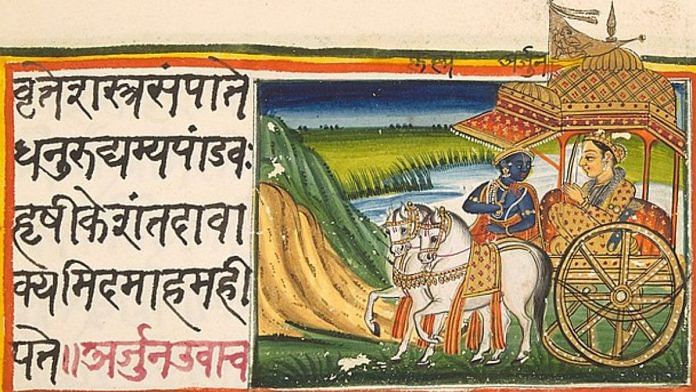Prime Minister Narendra Modi was ecstatic as he expressed the pride of millions of Indians. “The inclusion of the Gita and Natyashastra in UNESCO’s Memory of the World Register is a global recognition of our timeless wisdom and rich culture,” he wrote.
A proud moment for every Indian across the world!
The inclusion of the Gita and Natyashastra in UNESCO’s Memory of the World Register is a global recognition of our timeless wisdom and rich culture.
The Gita and Natyashastra have nurtured civilisation, and consciousness for… https://t.co/ZPutb5heUT
— Narendra Modi (@narendramodi) April 18, 2025
Memory of the World Register
UNESCO preserves the shared heritage of humanity through a register—a collection of documents that preserves the legacy of humankind. It’s a bank of knowledge that will be passed on to future generations, so centuries of knowledge are contained in these objects.
Historically, knowledge was preserved in India by learned people who spent their lives safeguarding it for future generations. These ancient teachers knew that no tangible form of knowledge, such as a book, could save it from destruction. So, it was shared through oral tradition, passing from one generation to another for posterity.
These teachers and students guarded their ancient wisdom with their lives, giving it more importance than material wealth. During all the invasions India faced in its history, this knowledge was guarded zealously, passed down as generational wealth. Ancient texts also existed, but they were destroyed when libraries were burned down.
The Bhagavad Gita is a 700-verse living heritage, which, scholars think, was composed between 200 to 400 BCE. Based on astronomical references and Hindu cosmology, however, it is suggested that the text was written in 3067 BCE or before. It is a spiritual-philosophical dialogue between Arjuna and Krishna, part of Ved Vyasa’s epic, the Mahabharata.
The Bhagavad Gita, which translates to ‘god’s song’, is composed of snippets of knowledge from the Vedas and the Upanishads. In terms of management principles, philosophy, and scientific discourse, it is considered as relevant today as it was in the ancient period.
Also read: Excavation is just the beginning. Complex sites like Kaushambi need evidence-based approach
Gita as management treatise
गतासूनगतासूंश्च नानुशोचन्ति पण्डिताः (Shloka 2.11)
“The wise do not grieve for the living or the dead.”
This verse can be interpreted in management terms to mean that a true leader or manager does not make decisions based on emotional turbulence or attachment to outcomes. In the verse, Krishna tells Arjuna not to grieve what is inevitable and beyond control. Similarly, a team leader must maintain strategic clarity by focusing on long-term goals, not temporary setbacks.
योगस्थ: कुरु कर्माणि सङ्गं त्यक्त्वा धनञ्जय |
सिद्ध्यसिद्ध्यो: समो भूत्वा समत्वं योग उच्यते || (Shloka 2.48)
“Be steadfast in the performance of your duty, O Arjun, abandoning attachment to success and failure. Such equanimity is called yoga.”
In modern management, it is believed that a true leader does not worry about success or failure. Rather, she remains focused on the performance of the tasks she has to complete. Equanimity in the face of failure is a crucial characteristic required of leaders, and the Gita teaches us this.
श्रेयान्स्वधर्मो विगुण: परधर्मात्स्वनुष्ठितात् |
स्वधर्मे निधनं श्रेय: परधर्मो भयावह: (Shloka 3.35)
“It is far better to perform one’s prescribed duty, though tinged with faults, than to perform another’s prescribed duty perfectly.”
In the modern context, this can be interpreted to mean that an effective leader knows their own strengths and weaknesses, and does not try to ape another. An effective leader follows their own lead. Trying to mimic others leads to inefficiency and dissatisfaction, which ultimately creates chaos in an organisation.
Also read: Away with Brahmin school-masters, we need schools for Shudras: Jyotirao Phule
Gita as a law book
सक्ता: कर्मण्यविद्वांसो यथा कुर्वन्ति भारत |
कुर्याद्विद्वांस्तथासक्तश्चिकीर्षुर्लोकसंग्रहम् || (Shloka 3.25)
“O Bharat [Arjun], just as the unwise act with attachment to their duties, so should the wise act without attachment, desiring the welfare of the world.”
The Bhagavad Gita emphasises the importance of fairness and impartiality. In the legal context, this tenet is in line with the concept of a free and fair judiciary. Lady Justice is blind, emphasising the objectivity and non-partisanship of the legal system.
यद्यदाचरति श्रेष्ठस्तत्तदेवेतरो जन: |
स यत्प्रमाणं कुरुते लोकस्तदनुवर्तते || (Shloka 3.21)
“Whatever actions great persons perform, common people follow. Whatever standards they set, all the world pursues.”
Interpreted as a diktat for the legal system, this implies that judges, lawmakers, and constitutional authorities set legal standards through their rulings or judicial conduct. Their actions, therefore, carry normative force, providing a role model of behaviour and expectations of society at large.
In constitutional law, this aligns with the concept that Supreme Court judgments or legal interpretations by eminent jurists become guiding principles for lower courts and the citizens. They shape public morality, rights discourse, and institutional behaviour. This reminds us that those entrusted with public office, legislative power, or judicial responsibility must act with utmost integrity and fairness.
Also read: Kautilya’s ‘Arthashastra’, Manu’s laws—Ancient India had rich literature on jurisprudence
Gita as astronomical science
I was recently invited to attend a lecture at IIT Delhi by nuclear medicine practitioner Dr Manish Pandit, on the exact dating of the Mahabharata. I was stupefied to learn the accurate astronomical capabilities of ancient Indians. By translating shlokas, Dr Pandit showed how data is precisely represented in the Bhagavad Gita. Even with my high-school level Sanskrit, I understood that Dr Pandit effectively proved how the Gita is a shockingly accurate astrological almanack.
To think that our ancestors were able to calculate accurate positions of stars and planets in the sky without the help of supercomputers and precise telescopes speaks volumes about their intellectual faculties. It underscores the need to preserve the Gita as a living tradition. Dr Pandit built upon the research of professor Narhari Achar, who taught at the Department of Physics at the University of Memphis, Tennessee, in the US. To accurately date the Mahabharata, Dr Pandit corroborated Achar’s work with the help of Planetarium software.
Using over 140 astronomical references from the Mahabharata, Achar simulated night skies to effectively date the start of the epic war. By aligning planetary positions and eclipses mentioned in the Udyoga and Bhisma Parva, he found that this date was 22 November, 3067 BCE. Dr Pandit’s research further strengthens my belief that the Bhagavad Gita is a divine chariot that will take us across to the supreme afterlife and show us the right path during our lifetime.
Also read: Ancient India’s battle of ideas: Yudhisthira & Arjuna are ideal kings. Don’t be like Ashoka
Bharat Muni’s Natyashastra
The Natyashastra is the oldest surviving compilation of performing arts in India, based on the Natasutras, which are said to predate even the Greek period of performing art or drama. In Indian Theatre: Traditions of Performance (1993), Farley Ricmond estimates the Natasutras to have been written in about 600 BCE.
Combining drama, aesthetics, and theology, the Natyashastra views performance as a spiritual ritual aimed at evoking deep emotion within the audience. It emphasises transcendence over mere entertainment, granting artists the creative freedom to bridge the divine and the human. Details about music, lighting on the stage, makeup and budgeting make the text fascinating and eternal.
Traditionally, art in India has been passed on from one generation to the next through the guru–shishya relationship. And the Natyashastra aims to collate this treasure trove as a small but significant fraction of the total bank of knowledge.
Bharat Muni’s Natyasastra and the Bhagavad Gita follow in the exalted footsteps of the Valmiki Ramayana.
True to the slogan, ‘Vikas bhi aur virasat bhi (development as well as heritage)’, we Indians should be proud of our living traditions and cultural heritage. The youth should be encouraged to embrace our culture and take pride in our knowledge systems.
UNESCO’s recognition of the value of our heritage has vindicated our stand. Intangible cultural heritage is like a charioteer, while tangible cultural heritage is the chariot itself. For a civilisation, its intangible cultural heritage is its lifeblood. There can be no Viksit Bharat without its younger generations taking pride in the great achievements of their ancestors. Only by doing so can they gain the confidence to face the challenges of the future.
Meenakshi Lekhi is a BJP leader, lawyer and social activist. Her X handle is @M_Lekhi. Views are personal.
(Edited by Prasanna Bachchhav)
var ytflag = 0;
var myListener = function() {
document.removeEventListener(‘mousemove’, myListener, false);
lazyloadmyframes();
};
document.addEventListener(‘mousemove’, myListener, false);
window.addEventListener(‘scroll’, function() {
if (ytflag == 0) {
lazyloadmyframes();
ytflag = 1;
}
});
function lazyloadmyframes() {
var ytv = document.getElementsByClassName(“klazyiframe”);
for (var i = 0; i < ytv.length; i++) {
ytv[i].src = ytv[i].getAttribute('data-src');
}
}








